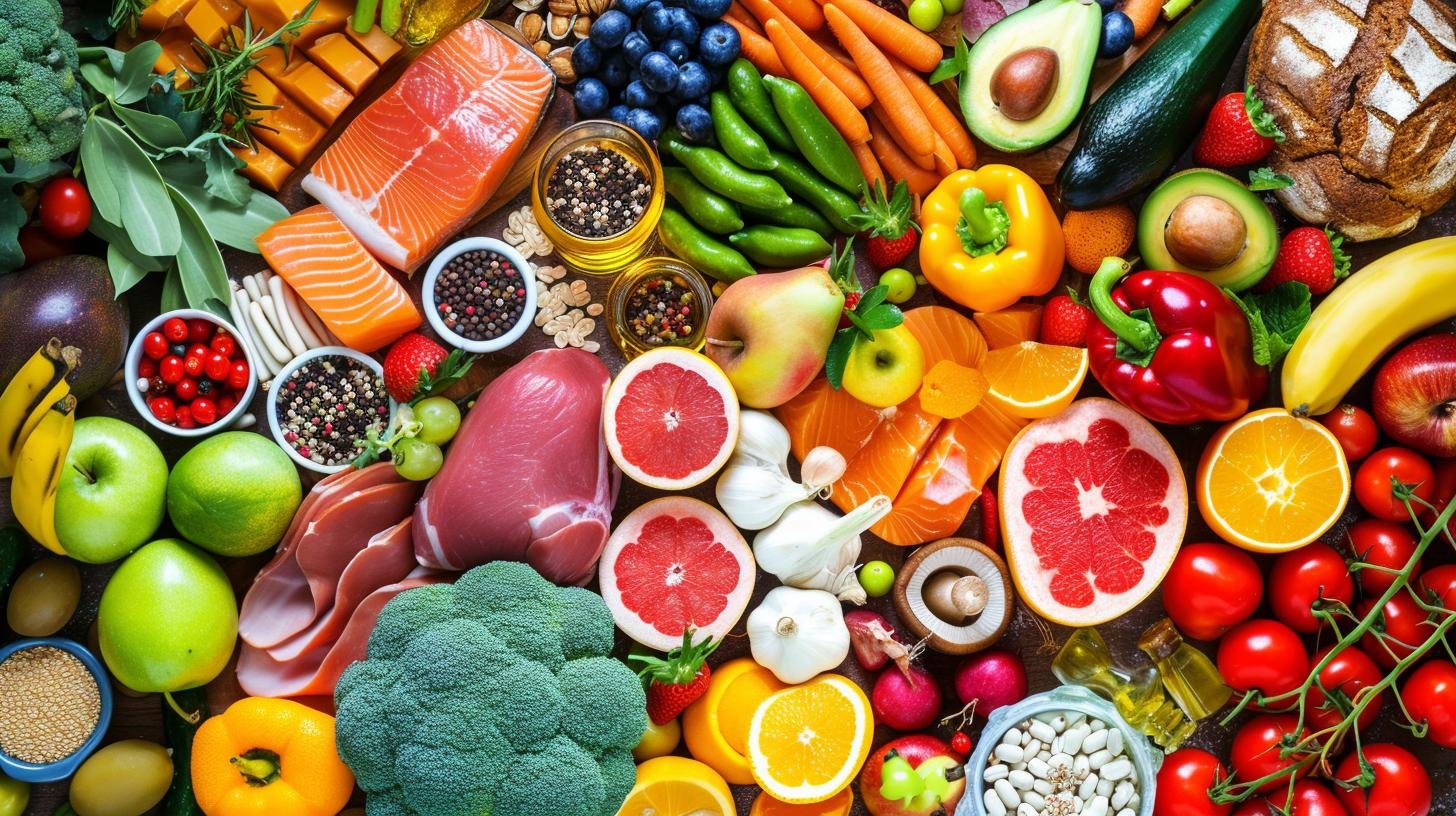Are you curious about the components of food and how they contribute to your overall health and well-being? In this article, we will explore the fundamental aspects of food components, including carbohydrates, proteins, fats, vitamins, minerals, and fiber.
As part of our discussion, we will delve into the essential nutrients found in different food groups and debunk common misconceptions about their roles in nutrition. Additionally, we will provide sample class 6 questions to test your understanding of the material and offer detailed answers to help reinforce your learning.
As students in class 6 begin to develop a deeper understanding of the science behind nutrition and healthy eating habits, it’s crucial to comprehend the basic components of food and how they function in the body. By exploring topics such as carbohydrates, proteins, fats, vitamins, minerals, and fiber, students can gain a holistic view of nutrition that will enable them to make informed choices about their diet.
One of the essential nutrients found in food is carbohydrates. We will discuss how carbohydrates serve as a primary source of energy for the body and examine different types of carbohydrates found in various foods. Additionally, we will explore the role of proteins in supporting growth and repair within the body. Students will learn about different sources of protein and why they are crucial for overall health.
Furthermore, we’ll uncover the importance of fats in the diet and dispel common misconceptions about their role in nutrition. By understanding the function of fats in the body and where to find healthy sources of fats, students can make informed decisions about their dietary choices. We’ll also shed light on vitamins and minerals as essential nutrients for maintaining proper bodily functions and promoting overall health.
In addition to exploring these individual components of food, we’ll discuss how to create a balanced diet that incorporates the right combination of nutrients from each category. This section will provide practical tips for developing healthy eating habits that promote overall well-being. Finally, we’ll offer sample class 6 questions related to these topics and provide detailed answers to common queries regarding the components of food.
Understanding the Basic Nutrients
Carbohydrates are one of the basic nutrients essential for the human body. They are the main source of energy for our bodies, providing fuel for physical activities and proper organ function. Understanding carbohydrates and their role in our diet is crucial for maintaining a healthy lifestyle.
Here are some key points to understand about carbohydrates:
- Carbohydrates are organic compounds made up of carbon, hydrogen, and oxygen.
- They are commonly found in foods such as bread, rice, pasta, fruits, and vegetables.
- There are two main types of carbohydrates: simple carbohydrates (sugars) and complex carbohydrates (starches and fiber).
Simple carbohydrates are quickly absorbed by the body and provide a rapid source of energy. However, consuming too much simple sugar can lead to health issues such as weight gain and tooth decay. On the other hand, complex carbohydrates take longer to digest and provide a more sustained release of energy. They also contain essential nutrients such as vitamins, minerals, and fiber that are beneficial for overall health.
It is important to include a variety of carbohydrates in our diet to ensure we receive all the necessary nutrients for our bodies to function properly. Class 6 students should be aware of the difference between “good” and “bad” carbs, so they can make informed choices when it comes to their food consumption.
In addition to being a major source of energy, carbohydrates play a crucial role in brain function. Glucose derived from carbohydrates is the primary fuel for the brain’s energy needs. Therefore, it is vital for students to understand the importance of including carbohydrate-rich foods in their diet to support cognitive functions during their studies.
As students learn about components of food class 6 questions and answers pertaining to carbohydrates will help reinforce their understanding of this important nutrient group. Answering questions about sources of carbohydrates or their impact on health can deepen their knowledge about making healthy food choices.
Exploring the Role of Proteins in Food
Proteins are an essential component of the human diet and play a crucial role in the overall health and well-being of individuals. Understanding the role of proteins in food is important for ensuring a balanced and nutritious diet. In this section, we will explore the importance of proteins, sources of protein, and their impact on the body.

Importance of Proteins
Proteins are often referred to as the building blocks of life, and for a good reason. They are necessary for the growth, repair, and maintenance of tissues in the body, including muscles, organs, and skin. Proteins also play a vital role in the production of enzymes, hormones, and other essential chemicals that enable various bodily functions.
Sources of Protein
Protein can be found in a variety of foods, both from plant and animal sources. Animal-based sources include meat, poultry, fish, eggs, and dairy products. Plant-based sources include beans, lentils, nuts, seeds, tofu, and soy products. It is important to incorporate a variety of protein sources into one’s diet to ensure adequate intake of essential amino acids.
Impact on the Body
When consumed, proteins are broken down into amino acids which are then used by the body to carry out various functions. Adequate protein intake is crucial for promoting muscle growth and repair after physical activity. Additionally, proteins play a key role in supporting immune function and maintaining proper fluid balance.
Overall, understanding the role of proteins in food is essential for maintaining optimal health. By incorporating a variety of protein sources into one’s diet and ensuring adequate intake, individuals can support their overall well-being while enjoying a balanced nutritional profile.
The Importance of Fats in the Diet
Fats are an essential component of food and play a crucial role in maintaining overall health. Despite being often vilified, fats are actually necessary for the body to function properly. In this section, we will explore the importance of fats in the diet and how they contribute to our well-being.
Types of Fats
There are different types of fats, including saturated fats, unsaturated fats, and trans fats. Saturated fats are commonly found in animal products such as butter and cheese, while unsaturated fats are found in foods like nuts, seeds, and vegetable oils. Trans fats are typically found in processed foods and should be limited in the diet due to their negative impact on health.
Energy Source
One of the primary roles of fats in the diet is to provide a concentrated source of energy. Fats contain more than twice the amount of energy per gram compared to carbohydrates and proteins, making them an efficient fuel for the body.
Cellular Function
Fats are also essential for cellular function and overall health. They help build cell membranes and play a vital role in the absorption of fat-soluble vitamins such as A, D, E, and K. Additionally, certain types of fats play a role in regulating inflammation and blood clotting.
Brain Health
The brain is composed primarily of fat, and dietary fats are important for brain development and function. Omega-3 fatty acids, found in fish and certain plant sources like flaxseeds, have been linked to cognitive function and may reduce the risk of age-related cognitive decline.
Balanced Diet
While it’s important to include healthy fats in the diet, it’s equally crucial to consume them in moderation. Choosing sources of unsaturated fats such as avocados, olive oil, nuts, and seeds can help promote heart health while minimizing intake of saturated and trans fats.
In summary, incorporating healthy sources of fat into our diets is essential for overall health. Understanding the different types of fats as well as their roles in energy production, cellular function, brain health, and maintaining a balanced diet is key to optimizing our nutritional intake.
Vitamins and Minerals
Vitamins are organic compounds that are necessary for normal growth and development. There are 13 essential vitamins that are categorized as either fat-soluble (A, D, E, K) or water-soluble (B vitamins and vitamin C). Each vitamin has specific functions in the body, such as promoting healthy vision (vitamin A), supporting bone health (vitamin D), and aiding in energy production (B vitamins).

Minerals, on the other hand, are inorganic elements that are critical for maintaining bodily functions. Some of the key minerals include calcium, iron, magnesium, zinc, and potassium. These minerals play a vital role in bone health, oxygen transport, muscle function, and fluid balance.
It is important to note that we need to obtain these vitamins and minerals from our diet since our body cannot produce them on its own. Fruits, vegetables, whole grains, lean proteins, and dairy products are excellent sources of vitamins and minerals. A balanced diet that includes a variety of nutrient-dense foods ensures that we get an adequate amount of these essential nutrients.
Inadequate intake of vitamins and minerals can lead to deficiencies and various health problems. For example, a lack of vitamin C can result in scurvy, while low levels of iron can lead to anemia. On the other hand, consuming excessive amounts of certain vitamins or minerals can also have negative effects on health. Therefore, it is important to meet the recommended daily intake of these nutrients for optimal health.
| Nutrient | Primary Function |
|---|---|
| Vitamin A | Promotes healthy vision |
| Vitamin D | Supports bone health |
| Vitamin C | Aids in immune function |
| Calcium | Essential for bone strength |
Understanding the roles of vitamins and minerals in the body emphasizes the importance of including a variety of nutrient-rich foods in our daily diet to support overall health and well-being.
Fiber
There are two main types of fiber: soluble fiber, which dissolves in water and can help lower cholesterol and control blood sugar levels, and insoluble fiber, which does not dissolve in water and adds bulk to the stool, aiding in its passage through the digestive tract. Both types of fiber are important for overall health and should be included in your daily diet.
It is recommended that children aged 6-12 consume about 25 grams of fiber per day. Good sources of fiber include whole grains such as brown rice and oatmeal, fruits like apples and berries, vegetables such as broccoli and carrots, as well as legumes like lentils and chickpeas. By incorporating a variety of these foods into their diet, children can ensure they are getting an adequate amount of fiber to support their digestive health.
Incorporating high-fiber foods into meals can be easy and delicious. For example, adding berries or banana slices to a bowl of oatmeal at breakfast or including a side of steamed broccoli with lunch or dinner can go a long way in increasing daily fiber intake. Encouraging children to eat a colorful variety of fruits and vegetables ensures that they are receiving all the essential nutrients, including fiber, necessary for their overall health.
Lastly, it’s important to increase fluid intake when consuming high-fiber foods to prevent constipation. Water is crucial for moving fiber through the digestive system effectively. Encouraging kids to drink water throughout the day will aid in proper digestion and ensure that the benefits of fiber are fully realized.
| Types of Fiber | Good Sources |
|---|---|
| Soluble Fiber | Fruits (e.g. apples), Legumes (e.g. lentils) |
| Insoluble Fiber | Whole Grains (e.g. brown rice), Vegetables (e.g. broccoli) |
Common Misconceptions About Food Components
When it comes to the components of food, there are several common misconceptions that many people have. These misconceptions can often lead to poor dietary choices and ultimately affect our overall health. It’s important to debunk these myths and understand the truth about the components of food.
Here are some of the most common misconceptions about food components:
1. Carbohydrates make you gain weight: Many people believe that carbohydrates are solely responsible for weight gain. However, not all carbohydrates are equal, and whole grains, fruits, and vegetables provide essential nutrients and fiber. It’s excessive consumption of refined carbohydrates and sugary foods that can contribute to weight gain.
2. All fats are bad: There is a misconception that all fats should be avoided in a healthy diet. In reality, fats are essential for our bodies as they provide energy and help in the absorption of fat-soluble vitamins. The key is choosing healthy fats like those found in avocados, nuts, and olive oil while limiting saturated and trans fats.

3. Proteins are only found in meat: Many people associate protein with meat products, but there are plenty of plant-based sources of protein such as legumes, tofu, quinoa, and nuts. It’s important to include a variety of protein sources in your diet to ensure you’re getting all essential amino acids.
4. Vitamins and minerals can be replaced with supplements: Some individuals believe that taking supplements can replace the need for consuming a balanced diet rich in vitamins and minerals from whole foods. However, supplements should complement a healthy diet rather than replace it entirely.
5. Fiber doesn’t matter: Some may overlook the importance of fiber in their diet, thinking that it’s not as crucial as other nutrients. In reality, fiber plays a vital role in digestion by promoting regular bowel movements and maintaining gut health.
It’s important to educate ourselves about these misconceptions so we can make informed decisions about our dietary habits based on facts rather than myths.
How to Create a Balanced Diet With the Right Components
Creating a balanced diet with the right components is essential for overall health and well-being. Understanding the different components of food and their role in the body can help individuals make informed choices about their diets. A balanced diet consists of carbohydrates, proteins, fats, vitamins, minerals, and fiber in the right proportions.
Carbohydrates are the body’s main source of energy. They can be found in foods such as bread, pasta, rice, and fruits. It is important to choose complex carbohydrates that are high in fiber and nutrients rather than simple carbohydrates like sugary snacks and drinks. Including a variety of whole grains, fruits, and vegetables in the diet can ensure a good intake of carbohydrates.
Proteins are essential for the growth and repair of tissues in the body. Foods such as meat, poultry, fish, eggs, dairy products, nuts, and legumes are all rich sources of protein. Incorporating a mix of these foods into meals can provide the body with all the essential amino acids it needs for optimal functioning.
Fats are important for energy storage, insulation, and protecting vital organs. However, not all fats are created equal. It is important to choose healthy fats found in foods like avocados, nuts, seeds, and olive oil while limiting trans fats and saturated fats found in processed and fried foods.
Vitamins and minerals play crucial roles in various bodily functions such as immune support, bone health, energy production, and enzyme regulation. A well-balanced diet should include a variety of fruits and vegetables to ensure an adequate intake of vitamins A, C, D as well as minerals like calcium potassium.
Fiber is important for digestive health as it helps regulate bowel movements and prevent constipation. Whole grains, legumes (beans), fruits.
and vegetables are all excellent sources of fiber that should be included in daily meals to support digestive health.
By understanding the importance of each component of food class 6 students or anyone interested can make informed choices to create balanced meals that meet their nutritional needs for optimal health.
Detailed Answers to Commonly Asked Questions About the Components of Food
In conclusion, understanding the components of food is essential for maintaining a healthy and balanced diet. Carbohydrates, proteins, fats, vitamins, minerals, and fiber are all vital for our overall health and well-being. By learning about the role of each nutrient in our diet, we can make informed choices about the foods we consume and ensure that we are meeting our nutritional needs.
Carbohydrates are our body’s primary source of energy, while proteins play a crucial role in building and repairing tissues. Fats are necessary for absorbing certain vitamins and protecting our organs. Vitamins and minerals are essential for various bodily functions, from supporting the immune system to aiding in metabolism. Fiber keeps our digestive system healthy and helps prevent constipation.
It’s important to be aware of common misconceptions about food components to make better dietary choices. For instance, not all fats are bad for you – unsaturated fats found in avocados and nuts can actually benefit your health. Likewise, not all carbohydrates are unhealthy; whole grains provide important nutrients and fiber.
Creating a balanced diet with the right components involves including a variety of foods from each food group. This means incorporating plenty of fruits, vegetables, whole grains, lean proteins, and healthy fats into your meals. By doing so, you can ensure that you’re getting all the essential nutrients your body needs to function optimally.

